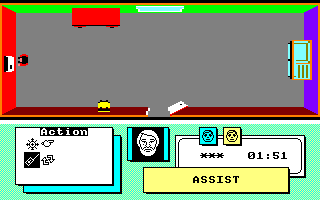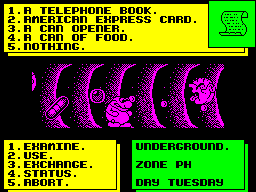
Tetris
(Mirrorsoft, 1987)
It’s the game that helped to sell huge numbers of Nintendo Game Boys, and everyone knows how to play it; make full rows of blocks by slotting together pieces which fall from the top of the screen. Unfortunately, this version doesn’t fare well at all; the graphics are garish, and the striped background is confusing. Add some terrible music and clumsy controls which can’t be redefined, and you don’t get a fun game. Thankfully, there are many other unofficial versions for the CPC in the public domain that are much better than this one.

As CPC owners we were never blessed with many quality one-on-one fighting games. There are a handful that are worth seeking out, but this isn’t really one of them. There are positives to trying this one, though. It’s got some good music to start with. I also like the way the fights take place. The two combatants can be seen circling each other during a bout so the fights have a 3D feel to them. The graphics are average at best, with a low colour count, but at least there are some changes in location and character portraits that take damage. The gameplay does become more of a tug of war than anything and at times you can get away with just one attack.
![]() Watch a YouTube video of this game by:
ChinnyVision.
Watch a YouTube video of this game by:
ChinnyVision.

Thanatos
(Durell, 1986)
The forces of the underworld must be defeated by the mighty dragon, Thanatos the Destroyer. It’s not often that you get the chance to play a dragon in a computer game. However, in order to complete your mission, you must first find and collect the beautiful sorceress Eros, and then fly onwards to find her spell book, and finally, fly to her cauldron where the spell can be cast. These are all to be found in locked castles, but the wooden entrance door can be burnt down. Your supply of fire is limited, and can be replenished by landing next to a witch, grabbing the knight from his horse and killing him, then eating the witch! There are many other unique things about this game; the parallax scrolling and animation of the dragon and the many opponents you can face are stunning, and the eight skill levels add a lot of replay value to this fantastic game.

This is a wargame taking place during the Cold War era. You can choose your side (NATO or the Warsaw Pact) and the difficulty level. Then you move your units on a map representing Europe (which is really well drawn, by the way). When you select a battle, the screen turns into a little arcade game where you must shoot tanks and aircraft. It doesn’t have a big influence on the results of the battles, however. At a certain point of the campaign, you can decide to use chemical or nuclear weapons, but this will often result in the complete destruction of the planet, so think twice before using them! A good, although a bit too repetitive, strategic game.

Fancy yourself as the next criminal mastermind? Well here’s your chance to play the part of Mr Big in your quest to steal your way to world domination! You have five targets to successfully loot – a coin dealer, an art gallery, a diamond merchant, a bank and a museum. On top of all of this, you need to hire a team, including lock-pickers, safe crackers, getaway drivers, and fences to shift the goods! The strategy doesn’t end there, as you also need to buy blueprints and security details. The graphics are good enough to do their job and the tune is just right for the mood. What really makes this game is the fun you have in the planning stages of it, and making sure you don’t get nicked as the job is being pulled off. You have to love the Macintosh-style menu system too. You’ve played the cop several times, now play the robber for a change!

Thing!
(Players, 1988)
Thing has been assigned to deliver The Ball to the Dingalinger Overlord. However, Thing must complete ten tasks before he is allowed to meet the Overlord. That’s definitely one of the weirdest plots I’ve heard for a game! The planet that Thing wanders is divided into 26 zones which he can teleport between using a telephone box. There are lots of objects scattered over these zones, and it’s up to you to discover which ones are used to complete tasks – but you are not informed when you have completed any! You must also avoid contact with the bouncing gargoyles which will cost you one of your five lives. The graphics tell you instantly that this game is a Spectrum port, and Thing moves at such a snail-like pace that the aim of the game seems to be to try to stay awake.

Thing is on a mission to locate parts of a computer program which will stop the production of evil toys that the factory he’s in is churning out. Now this is no easy task, as not only is the game immense, and not only are there typically weird bad guys everywhere, but also Thing, only being able to jump, is one of the hardest game characters ever to control! On the plus side, though, the graphics are great – lots of detail and very colourful, and Thing is a cute little guy – and the sound is OK too; nothing great, but serviceable. In fact, the game is way above average; it’s just so hard! But just suspend the belief that you’ll ever finish it, and you’ll find a pretty fun game here. It’s got everything a platform gamer could desire.
See also: Thing on a Spring.

The evil Goblin is causing chaos by casting spells and banishing the Earth’s treasures to his underground lair. Only one thing can break the spell – completing a magical jigsaw – and only one hero can do the job – Thing on a Spring! Great... I guess we can kiss the Earth’s treasures goodbye then. Joking aside, though, this game is seriously frustrating. Not only are the jigsaw pieces scattered around in some of the most out-of-the-way corners of the Goblin’s lair, but Thing has one of the hardest-to-control jumps in gaming history. Add to this the large number of seemingly unavoidable enemies and the many instances where you get stuck with no way of progressing, and you have a seriously annoying game. There’s a great catchy tune, but the sequel is an improvement in every way.
See also: Thing Bounces Back.

Thingy and the Doodahs
(Silverbird, 1987)
You’ve been told to go down to the second-hand shop and find £60 to buy a computer. Starting in your own bedroom, you search the house collecting £1 coins and avoiding the enemies that wander about the rooms. Then it’s off into the garden and the forest, through to more sets of mazes, more coins to collect, and more enemies to avoid. It’s a really simple kind of game with awful graphics that look as though it’s written in BASIC (although it isn’t), and the less said about the tune, the better. It’s a game that will only be remembered for its extremely silly name.

Think!
(Ariolasoft, 1986)
This is a board game for two players using a 6×6 grid. Each player must try to align four of their counters in a row either horizontally, vertically or diagonally. However, instead of placing counters on to any tile, a counter must be pushed on to one of the squares at the bottom or right of the board, and all the other counters in that row or column are shifted upwards or to the left as appropriate. The rules are very simple, but it makes for an extremely challenging game which requires a lot of thinking – hence the name. There are several different modes of play, including a tutorial mode and several problem-solving puzzles in which the board is already laid out for you. This is an excellent game for the intellectuals out there.
